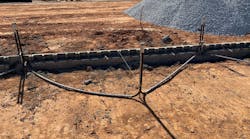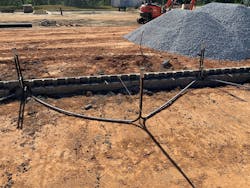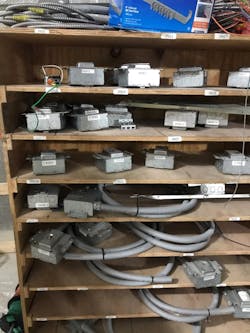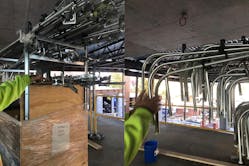Without upfront planning, continuous communication throughout the project, and a feedback loop from the field to the shop after project completion, electrical contractors may fall prey to one or more of these common pitfalls.
Incorrect dimensions
Specify dimensions when requesting prefab to avoid the potential need for manipulation on site. As shown in Photo 1, this crew had to re-orchestrate conduit runs and cut into concrete blocks to fit bends that were made at the shop.
Overproduction
Quantify items needed as much as possible and avoid early mass production where changes are anticipated. A review of the drawings and count of items at the beginning of a job will eliminate the potential risk of major overproduction and the need for return or repurpose of prefabricated items. A phased approach to production and communication of design changes can also keep any overproduction risk to a minimum.
Bad assumptions
Include the prefab shop in plans on how the job will be built. Communicating details like whether the pipe will be roughed in overhead versus in the wall can reduce the chances of the shop making incorrect assumptions and supplying incompatible items. On a recently completed project, the prefab shop built boxes to go in the ceiling, and once they arrived on site, the crew then had to take them apart and remake them for the walls. Another approach that can minimize the impact of incorrect assumptions or differences between BIM and the reality of the job site (Photo 2) is to build a sample in the shop, test it on the site, and, once successfully installed, build the rest.
Omitting a plan for logistics
Once you have identified prefab opportunities on your project, nailed down the specifics, and are ready to get started, it can be easy to overlook details for packaging, delivery, and handling on the job site.
Without thinking through the logistics, you may end up running into a few of the following issues:
- Damaged or unusable material
- Duplicated effort in packaging and waste removal (one in the shop, and again on the job site)
- Extra storage of material onsite (weeks or months before it is needed, with risk of damage)
- Difficulty moving material onsite
An example of difficulties in moving materials around a job site is shown in Photo 3. The conduit stubs, although they saved installation time, posed some handling challenges.
Entry between floors wasn’t wide enough, so they had to be removed from the cart, brought in, and placed back on the rack. Then, they were rolled to the necessary location. Due to how they were stacked, the crew also struggled to remove one item at a time from the rack.
Moving forward
New ways of performing work can undoubtedly come with challenges and growing pains. Rather than sweeping issues under the rug — or going back to traditional familiar methods of installation — it is critical to capture feedback when issues or difficulties occur so that the organization can learn and improve their operations in the shop on the next job.
Dr. Perry Daneshgari is president and CEO of MCA, Inc., Grand Blanc, Mich. He can be reached at [email protected]. Sydney Parvin is an associate data analyst and technical assistant to the VP of Operations at MCA, Inc., Grand Blanc, Mich. She can be reached at [email protected].






